油砂
- 格式:ppt
- 大小:5.13 MB
- 文档页数:36
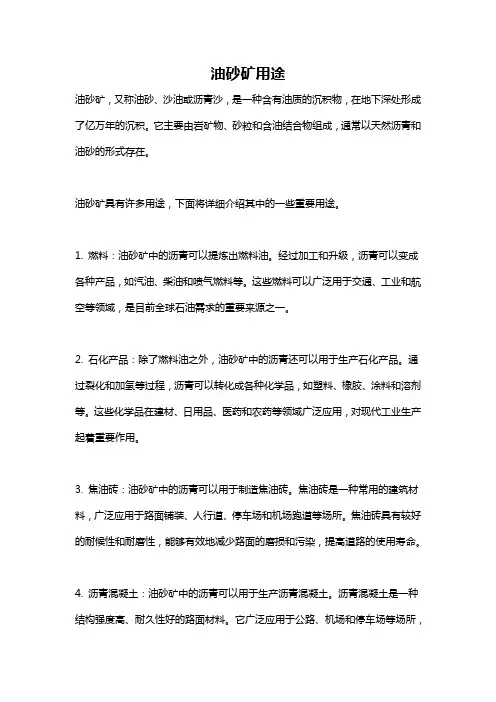
油砂矿用途油砂矿,又称油砂、沙油或沥青沙,是一种含有油质的沉积物,在地下深处形成了亿万年的沉积。
它主要由岩矿物、砂粒和含油结合物组成,通常以天然沥青和油砂的形式存在。
油砂矿具有许多用途,下面将详细介绍其中的一些重要用途。
1. 燃料:油砂矿中的沥青可以提炼出燃料油。
经过加工和升级,沥青可以变成各种产品,如汽油、柴油和喷气燃料等。
这些燃料可以广泛用于交通、工业和航空等领域,是目前全球石油需求的重要来源之一。
2. 石化产品:除了燃料油之外,油砂矿中的沥青还可以用于生产石化产品。
通过裂化和加氢等过程,沥青可以转化成各种化学品,如塑料、橡胶、涂料和溶剂等。
这些化学品在建材、日用品、医药和农药等领域广泛应用,对现代工业生产起着重要作用。
3. 焦油砖:油砂矿中的沥青可以用于制造焦油砖。
焦油砖是一种常用的建筑材料,广泛应用于路面铺装、人行道、停车场和机场跑道等场所。
焦油砖具有较好的耐候性和耐磨性,能够有效地减少路面的磨损和污染,提高道路的使用寿命。
4. 沥青混凝土:油砂矿中的沥青可以用于生产沥青混凝土。
沥青混凝土是一种结构强度高、耐久性好的路面材料。
它广泛应用于公路、机场和停车场等场所,可以提供良好的行车平顺性、降低交通噪音以及防止水泥路面开裂和松动。
5. 润滑剂:油砂矿中的沥青还可以用于制造润滑剂。
润滑剂在机械工业中起到润滑减摩、保护和防锈的作用,广泛应用于发动机、齿轮、轴承和润滑系统等设备中,是确保机械正常运行和延长使用寿命的关键因素。
此外,油砂矿在采矿过程中产生的矿渣和尾矿也可以进行资源化利用。
矿渣可以用于建材生产,例如生产水泥和砖瓦等。
尾矿可以进行尾砂回收和沉积物处理,以最大程度地减少环境污染。
需要注意的是,油砂矿的开采和利用也存在一些环境和社会问题。
由于油砂矿开采需要大量的水和能源消耗,产生的温室气体和废水排放会对环境造成影响。
此外,油砂开采还可能导致土地和水资源的竞争,对当地社区和原住民造成不利影响。

油砂分离专利技术
油砂分离是指通过一系列物理和化学工艺将油砂中的油和矿物质分离出来的过程。
以下是一些常见的油砂分离专利技术:
1. 油砂剪切分离技术:通过使用机械设备对油砂进行剪切,将油与砂分离。
这种技术适用于粘度较高的油砂。
2. 热水分离技术:通过加热含油砂和水的混合物,使油和水分离。
加热可以降低油砂的粘度,从而更容易分离。
3. 化学处理技术:包括使用化学溶剂或表面活性剂来改变油砂和油水界面的性质,从而促进分离。
4. 浮选分离技术:通过在油砂中添加空气泡沫或化学药剂,使油砂颗粒在水中浮起,从而实现分离。
5. 磁选分离技术:利用油砂中矿物质中的磁性特性,通过磁力将油砂颗粒和油分离。
这些技术在实际应用中可以单独或组合使用,根据油砂的特性和分离效率的要求选择合适的技术。
不同的技术可能适用于不同类型的油砂和分离目标。

油砂矿市场发展现状油砂矿是一种含有大量油砂资源的地质产物,具有丰富的石油资源潜力。
随着全球能源需求的不断增长,油砂矿市场的发展也备受关注。
本文将对油砂矿市场的发展现状进行分析和概述。
1. 油砂矿概述油砂矿是指地下或地表堆积的富含油砂的矿体,主要由砂岩、泥页岩和沥青组成。
其中的沥青是一种含有丰富原油的凝胶状物质。
油砂矿被广泛认为是未来石油资源开发的重要方向之一,因其蕴含的大量油砂储量对于解决能源短缺问题具有巨大潜力。
2. 全球油砂矿市场发展现状目前,全球油砂矿市场发展较为活跃,在一些国家和地区已经进行了大规模的油砂资源开发。
主要的油砂矿开发国家包括加拿大、委内瑞拉、美国等。
这些国家拥有丰富的油砂储量,成为全球油砂矿市场的主要参与者。
2.1 加拿大油砂市场加拿大是全球最大的油砂矿开发国家之一,在亚塔巴斯加油砂地区拥有世界上最大的油砂储量。
加拿大油砂市场的发展主要集中在阿尔伯塔省,该地区拥有约1700亿桶的可开采油砂储量。
加拿大油砂市场以其丰富的资源和成熟的开发技术而闻名,为加拿大经济做出了重要贡献。
2.2 委内瑞拉油砂市场委内瑞拉是世界上拥有最多油砂储量的国家之一,主要集中在奥里诺科地区。
该地区的石油资源储量约为310亿桶,是全球最大的单个油砂区块。
委内瑞拉油砂市场的发展受到了技术和资金的限制,但随着技术的进步和国际投资的增加,委内瑞拉油砂市场具有巨大的潜力。
2.3 美国油砂市场美国也是全球重要的油砂矿市场之一,主要集中在加州、堪萨斯、堪萨斯和德克萨斯等地。
美国拥有丰富的油砂资源储量,尤其是德克萨斯州的布拉索地区被认为是全球最大的油砂储量之一。
然而,由于环保和社会反对等因素,美国油砂市场的发展面临一些困难。
3. 油砂矿市场的挑战和机遇尽管油砂矿市场具有巨大的潜力,但其发展面临许多挑战和机遇。
3.1 挑战首先,油砂矿的开采和加工过程对环境和生态造成一定的影响,包括土地破坏、水源污染等。
这些环境问题使得油砂矿的开发备受关注,并引发了环保组织和公众的抗议。
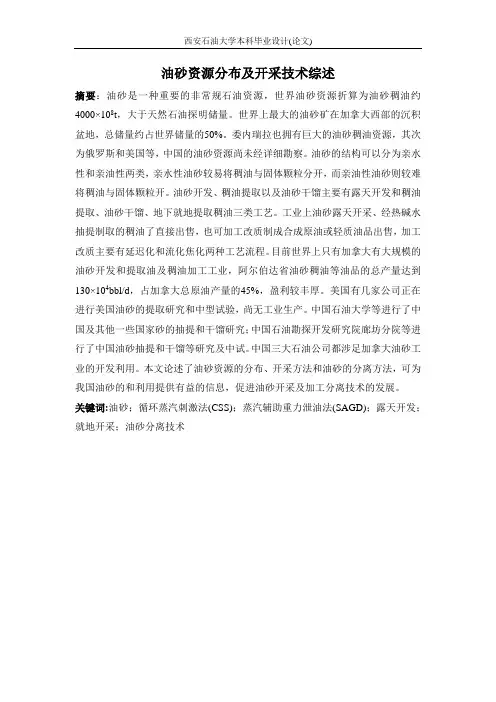
油砂资源分布及开采技术综述摘要:油砂是一种重要的非常规石油资源,世界油砂资源折算为油砂稠油约4000×108t,大于天然石油探明储量。
世界上最大的油砂矿在加拿大西部的沉积盆地,总储量约占世界储量的50%。
委内瑞拉也拥有巨大的油砂稠油资源,其次为俄罗斯和美国等,中国的油砂资源尚未经详细勘察。
油砂的结构可以分为亲水性和亲油性两类,亲水性油砂较易将稠油与固体颗粒分开,而亲油性油砂则较难将稠油与固体颗粒开。
油砂开发、稠油提取以及油砂干馏主要有露天开发和稠油提取、油砂干馏、地下就地提取稠油三类工艺。
工业上油砂露天开采、经热碱水抽提制取的稠油了直接出售,也可加工改质制成合成原油或轻质油品出售,加工改质主要有延迟化和流化焦化两种工艺流程。
目前世界上只有加拿大有大规模的油砂开发和提取油及稠油加工工业,阿尔伯达省油砂稠油等油品的总产量达到130×104bbl/d,占加拿大总原油产量的45%,盈利较丰厚。
美国有几家公司正在进行美国油砂的提取研究和中型试验,尚无工业生产。
中国石油大学等进行了中国及其他一些国家砂的抽提和干馏研究;中国石油勘探开发研究院廊坊分院等进行了中国油砂抽提和干馏等研究及中试。
中国三大石油公司都涉足加拿大油砂工业的开发利用。
本文论述了油砂资源的分布、开采方法和油砂的分离方法,可为我国油砂的和利用提供有益的信息,促进油砂开采及加工分离技术的发展。
关键词:油砂;循环蒸汽刺激法(CSS);蒸汽辅助重力泄油法(SAGD);露天开发;就地开采;油砂分离技术Resource distribution and exploitation of oil sandstechnology ReviewAbstract:The oil sands is an important unconventional oil resources, the world's oil sands resources are converted into oil sands, heavy oil of about 4000 × 108t, greater than the natural oil proved reserves. The world's largest oil sands in western Canada sedimentary basin, the total reserves of about 50 percent of world reserves. V enezuela has huge resources of oil sands, heavy oil, followed by Russia and the United States, China's oil sands resources has not been a detailed investigation. The structure of the oil sands can be divided into hydrophilic and lipophilic two types of hydrophilic oil sands easier to separate heavy oil and solid particles, lipophilic oil sands is more difficult to open the heavy oil and solid particles. Oil sands development, the dry distillation of heavy oil extraction and oil sands open development and heavy oil extraction, the dry distillation of oil sands underground, in situ extraction of heavy oil three types of technology. Industrial oil sands open pit mining, sold directly by the hot alkaline extraction preparation of heavy oil can be processed, but also made of modified synthetic crude oil or light oil for sale, processing modified delay and fluidized coking two kinds of process. World, only Canada has a large-scale oil sands development and extraction of oil and heavy oil processing industry, the Alberta oil sands heavy oil production reached 130 × 104bbl / d, accounting for 45% of Canada's total crude oil production , the more profitable lucrative. The United States there are a few ongoing oil sands extraction research and medium-sized trial, there is no industrial production. China Petroleum University of China and some other countries of sand extraction and the dry distillation of research; Langfang Branch of China Petroleum Exploration and Development Institute, Chinese oil sand extraction and distillation of such as research and pilot. China's three major oil companies are involved in the development and utilization of the Canadian oil sands industry. This paper discusses the distribution of oil sands resources, mining methods a nd the separation of the oil sands can provide useful information for China's oil sands and utilization to promote the development of oil sands mining and processing of separation technology.Key words:Oil sands;Cyclic steam stimulation;Steam assisted gravity drainage method;Open development;In situ mining;Oil sands separation technology目录1绪论 (1)1.1本文研究的目的及意义 (1)1.2国内外现状 (2)1.3本文研究的主要内容 (10)2国内外油砂的资源量,埋藏地点和矿藏特征 (11)2.1加拿大油砂资源量,埋藏地点和矿藏特征 (12)2.2其他国外油砂资源量,埋藏地点和矿藏特征 (13)2.3国内油砂资源量,埋藏地点和矿藏特征 (13)3世界油砂资源主要的开采技术 (16)3.1国外油砂资源开采技术 (16)3.2国内油砂资源开采技术 (21)3.3国内外油砂资源与开采技术对比 (24)4我国油砂资源开发技术展望 (26)4.1我国目前油砂资源开发程度 (26)4.2我国油砂资源开发技术的发展现状 (26)4.3我国油砂资源开发面临的困难 (26)5结论和建议 (28)5.1结论 (28)5.2建议 (28)参考文献 (30)致谢 (31)1绪论1.1本文研究的目的及意义油砂是一种含有天然沥青的砂岩或其他岩石,是由砂、沥青、矿物质、粘土和水组成的混合物。

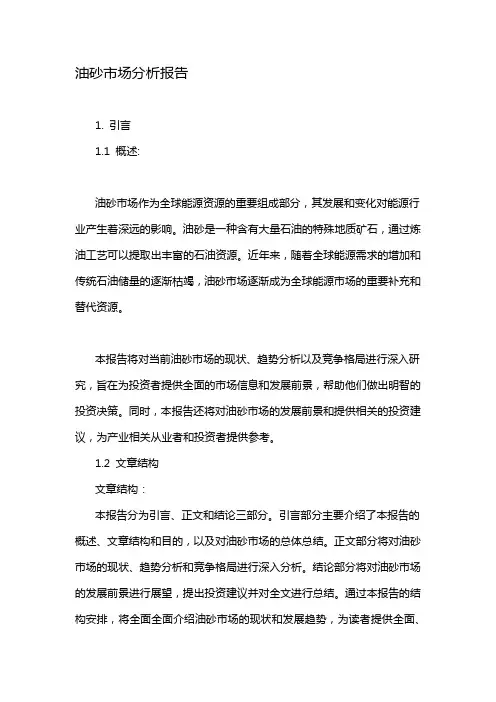
油砂市场分析报告1. 引言1.1 概述:油砂市场作为全球能源资源的重要组成部分,其发展和变化对能源行业产生着深远的影响。
油砂是一种含有大量石油的特殊地质矿石,通过炼油工艺可以提取出丰富的石油资源。
近年来,随着全球能源需求的增加和传统石油储量的逐渐枯竭,油砂市场逐渐成为全球能源市场的重要补充和替代资源。
本报告将对当前油砂市场的现状、趋势分析以及竞争格局进行深入研究,旨在为投资者提供全面的市场信息和发展前景,帮助他们做出明智的投资决策。
同时,本报告还将对油砂市场的发展前景和提供相关的投资建议,为产业相关从业者和投资者提供参考。
1.2 文章结构文章结构:本报告分为引言、正文和结论三部分。
引言部分主要介绍了本报告的概述、文章结构和目的,以及对油砂市场的总体总结。
正文部分将对油砂市场的现状、趋势分析和竞争格局进行深入分析。
结论部分将对油砂市场的发展前景进行展望,提出投资建议并对全文进行总结。
通过本报告的结构安排,将全面全面介绍油砂市场的现状和发展趋势,为读者提供全面、客观的市场分析。
1.3 目的目的部分的内容:本报告的目的在于对当前油砂市场进行深入分析,揭示行业现状、趋势和竞争格局,为相关投资者提供全面的市场分析报告。
通过对油砂市场的发展前景进行研究,为投资者提供专业的投资建议,帮助他们在市场竞争激烈的环境中取得更好的投资回报。
同时,本报告也旨在为行业相关企业提供参考,帮助它们更好地了解市场动态,制定更有效的市场营销策略和产品规划,提高市场竞争力。
1.4 总结通过对油砂市场现状、趋势分析以及竞争格局的深入研究,我们可以得出结论:油砂市场正处于快速发展的阶段,市场规模不断扩大,市场需求持续增长。
随着新能源产业的兴起,油砂市场将迎来更多的机遇和挑战。
在未来的发展中,需要重点关注技术创新和产品质量提升,以适应市场需求的变化。
我们相信,油砂市场具有广阔的发展前景,对于投资者而言,应该密切关注市场动态,把握时机,加大对油砂市场的投资力度。
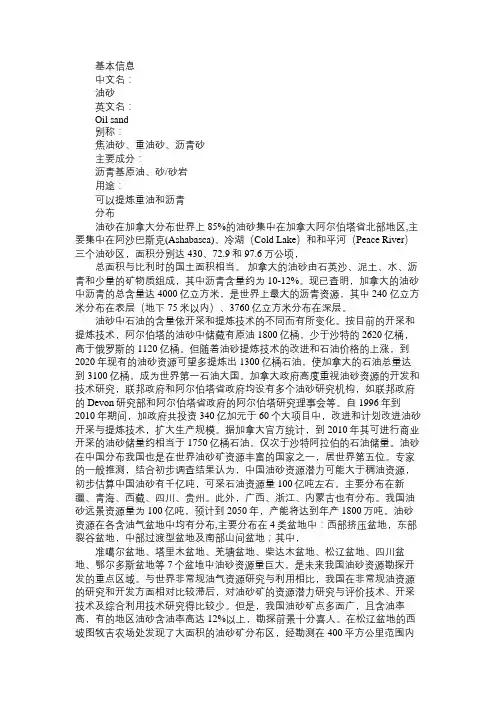
基本信息中文名:油砂英文名:Oil sand别称:焦油砂、重油砂、沥青砂主要成分:沥青基原油、砂/砂岩用途:可以提炼重油和沥青分布油砂在加拿大分布世界上85%的油砂集中在加拿大阿尔伯塔省北部地区,主要集中在阿沙巴斯克(Ashabasca)、冷湖(Cold Lake)和和平河(Peace River)三个油砂区,面积分别达430、72.9和97.6万公顷,总面积与比利时的国土面积相当。
加拿大的油砂由石英沙、泥土、水、沥青和少量的矿物质组成,其中沥青含量约为10-12%。
现已查明,加拿大的油砂中沥青的总含量达4000亿立方米,是世界上最大的沥青资源,其中240 亿立方米分布在表层(地下75米以内)、3760亿立方米分布在深层。
油砂中石油的含量依开采和提炼技术的不同而有所变化。
按目前的开采和提炼技术,阿尔伯塔的油砂中储藏有原油1800亿桶,少于沙特的2620亿桶,高于俄罗斯的1120亿桶。
但随着油砂提炼技术的改进和石油价格的上涨,到2020年现有的油砂资源可望多提炼出1300亿桶石油,使加拿大的石油总量达到3100亿桶,成为世界第一石油大国。
加拿大政府高度重视油砂资源的开发和技术研究,联邦政府和阿尔伯塔省政府均设有多个油砂研究机构,如联邦政府的Devon研究部和阿尔伯塔省政府的阿尔伯塔研究理事会等。
自1996年到2010年期间,加政府共投资340亿加元于60个大项目中,改进和计划改进油砂开采与提炼技术,扩大生产规模。
据加拿大官方统计,到2010年其可进行商业开采的油砂储量约相当于1750亿桶石油,仅次于沙特阿拉伯的石油储量。
油砂在中国分布我国也是在世界油砂矿资源丰富的国家之一,居世界第五位。
专家的一般推测,结合初步调查结果认为,中国油砂资源潜力可能大于稠油资源,初步估算中国油砂有千亿吨,可采石油资源量100亿吨左右。
主要分布在新疆、青海、西藏、四川、贵州。
此外,广西、浙江、内蒙古也有分布。
我国油砂远景资源量为100亿吨,预计到2050年,产能将达到年产1800万吨。
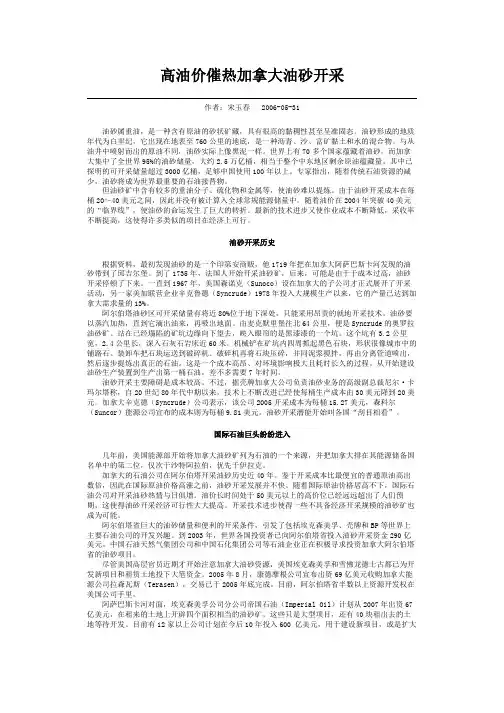
高油价催热加拿大油砂开采作者:宋玉春2006-05-31油砂属重油,是一种含有原油的砂状矿藏,具有很高的黏稠性甚至呈准固态。
油砂形成的地质年代为白垩纪,它出现在地表至760公里的地底,是一种沥青、沙、富矿黏土和水的混合物。
与从油井中喷射而出的原油不同,油砂实际上像黑泥一样。
世界上有70多个国家蕴藏着油砂,而加拿大集中了全世界95%的油砂储量,大约2.5万亿桶,相当于整个中东地区剩余原油蕴藏量。
其中已探明的可开采储量超过3000亿桶,足够中国使用100年以上。
专家指出,随着传统石油资源的减少,油砂将成为世界最重要的石油接替物。
但油砂矿中含有较多的重油分子、硫化物和金属等,使油砂难以提炼。
由于油砂开采成本在每桶20~40美元之间,因此并没有被计算入全球常规能源储量中。
随着油价在2004年突破40美元的“临界线”,使油砂的命运发生了巨大的转折。
最新的技术进步又使作业成本不断降低,采收率不断提高,这使得许多类似的项目在经济上可行。
油砂开采历史根据资料,最初发现油砂的是一个印第安商贩,他1719年把在加拿大阿萨巴斯卡河发现的油砂带到了邱吉尔堡。
到了1735年,法国人开始开采油砂矿,后来,可能是由于于成本过高,油砂开采停顿了下来。
一直到1967年,美国森诺克(Sunoco)设在加拿大的子公司才正式展开了开采活动,另一家美加联营企业辛克鲁德(Syncrude)1978年投入大规模生产以来,它的产量已达到加拿大需求量的13%。
阿尔伯塔油砂区可开采储量有将近80%位于地下深处,只能采用昂贵的就地开采技术。
油砂要以蒸汽加热,直到它滴出油来,再吸出地面。
由麦克默里堡往北64公里,便是Syncrude的奥罗拉油砂矿。
站在已经塌陷的矿坑边缘向下望去,映入眼帘的是黑漆漆的一个坑。
这个坑有3.2公里宽,2.4公里长,深入石灰石岩床近60米。
机械铲在矿坑内四周抓起黑色石块,形状很像城市中的铺路石。
装卸车把石块运送到破碎机。
破碎机再将石块压碎,并同泥浆搅拌,再由分离管道喷出,然后逐步提炼出真正的石油。
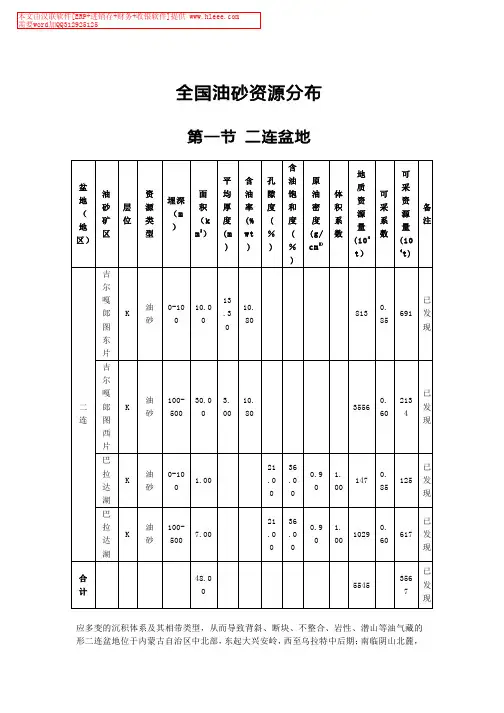

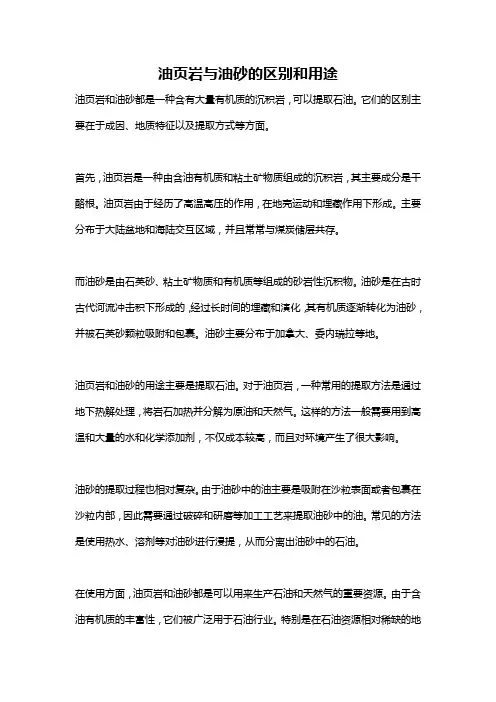
油页岩与油砂的区别和用途油页岩和油砂都是一种含有大量有机质的沉积岩,可以提取石油。
它们的区别主要在于成因、地质特征以及提取方式等方面。
首先,油页岩是一种由含油有机质和粘土矿物质组成的沉积岩,其主要成分是干酪根。
油页岩由于经历了高温高压的作用,在地壳运动和埋藏作用下形成。
主要分布于大陆盆地和海陆交互区域,并且常常与煤炭储层共存。
而油砂是由石英砂、粘土矿物质和有机质等组成的砂岩性沉积物。
油砂是在古时古代河流冲击积下形成的,经过长时间的埋藏和演化,其有机质逐渐转化为油砂,并被石英砂颗粒吸附和包裹。
油砂主要分布于加拿大、委内瑞拉等地。
油页岩和油砂的用途主要是提取石油。
对于油页岩,一种常用的提取方法是通过地下热解处理,将岩石加热并分解为原油和天然气。
这样的方法一般需要用到高温和大量的水和化学添加剂,不仅成本较高,而且对环境产生了很大影响。
油砂的提取过程也相对复杂。
由于油砂中的油主要是吸附在沙粒表面或者包裹在沙粒内部,因此需要通过破碎和研磨等加工工艺来提取油砂中的油。
常见的方法是使用热水、溶剂等对油砂进行浸提,从而分离出油砂中的石油。
在使用方面,油页岩和油砂都是可以用来生产石油和天然气的重要资源。
由于含油有机质的丰富性,它们被广泛用于石油行业。
特别是在石油资源相对稀缺的地区,人们对油页岩和油砂的开发利用有着较高的期望。
此外,油页岩和油砂提取石油的方式不同,也会对环境产生不同的影响。
油页岩的提取过程中可能会产生大量的废水、废渣和尾气,对环境产生较大破坏。
而油砂的提取过程中也会消耗大量的水资源,并且废水难以达标排放,对当地水资源和生态环境带来极大的压力。
此外,油砂和油页岩开采所需的基建和设备投资非常庞大,资金和技术要求较高。
同时,石油价格的波动也可能对开采经济性产生影响。
因此,在资源开发的过程中,需要综合考虑开采成本、环境效应和经济可行性等因素。
总之,油页岩和油砂是两种重要的石油资源,它们的区别在于成因、地质特征以及提取方式等方面。
油砂怎么处理油砂处理技术包括溶剂萃取、化学热洗处理和裂解处理等。
其中溶剂萃取处理就是在油泥油砂中加入萃取溶剂,将里面的油类分离出来,用于再生利用;化学热洗处理就是将工业油泥加水稀释后再加热,同时投加一定量化学试剂反复清洗,使油从固相表面脱附或聚集分离;裂解处理技术是指在加热的条件下,通过油泥处理设备将工业油泥中的重质油类分解成燃油。
油砂的成分:油砂是指富含天然沥青的沉积砂。
因此也称为“沥青砂”。
油砂实质上是一种沥青、沙、富矿粘土和水的混合物,其中,沥青含量为10~12%,沙和粘土等矿物占80~85%,余下为3~5%的水。
具有高密度、高粘度、高碳氢比和高金属含量的油砂沥青油。
注意,在有些沉积例如西加拿大“油砂”沉积当中,天然沥青的含量在一些诸如粉砂岩、碳酸盐的岩性当中可能占主导地位。
方法一简单处理含油污泥直接填埋或固化后填埋都具有简单易行的特点。
含油污泥直接填埋是目前多数国内油田采用的主要含油污泥处理方法。
简单处理的弊端这种方法既浪费了其中的宝贵能源,还有可能导致环境污染。
其中,固化后填埋的方法可降低环境危害,但根本不能满足现行的环保要求。
方法二萃取法萃取法是利用“相似相溶”原理,选择一种合适的有机溶剂作萃取剂,将含油污泥中的原油回收利用的方法。
利用多级分离萃取加一级热洗方法处理含油污泥,处理后污泥可达到农用污泥排放标准,化学药剂可循环使用。
萃取法的弊端超临界流体萃取技术,该技术正处于开发阶段。
目前,萃取法处理含油污泥还在试验开发阶段;但是由于萃取剂价格昂贵,而且在处理过程中有一定的损失,所以萃取法成本高,还没有实际应用于炼厂含油污泥处理。
方法三焚烧法经过预先脱水浓缩预处理后的含油污泥,送至焚烧炉进行焚烧,温度800~850℃,经30分钟焚烧即可完毕,焚烧后的灰渣需进一步处理。
焚烧法的弊端焚烧过程中产生了二次污染,浪费了宝贵资源。
焚烧必须在专门建立的焚烧炉中进行,可比较彻底地消除含油污泥中的有害有机物,如不考虑燃烧热能的综合利用,会造成能源浪费。
油砂名词解释
油砂是一种含有大量油质的沉积岩,由砂粒、砾石等碎屑物颗粒组成,通过沉积作用形成。
油砂中的油质主要是腐殖质和干酪根等有机物质,它们在地质历史中经过高温高压作用转化而成。
油砂主要分布在河流、湖泊、海岛等水体沉积的地区。
油砂是一种非常重要的能源资源,具有巨大的石油储量。
它的开发利用可以提供大量的石油和石油产品,满足能源需求。
近年来,随着全球能源供应紧张和能源需求的增长,油砂的开发利用越来越受到关注。
在油砂的开发过程中,通常采用采矿、破碎、浸提等方法。
首先,通过采矿将油砂从地下或地表开采出来;然后,将开采出来的油砂进行破碎处理,使其颗粒更加细小;最后,利用溶剂进行浸提,将油砂中的油质分离出来。
油砂开采和利用过程中存在一些问题和挑战。
首先,油砂开采对环境造成了一定程度的破坏,例如土地资源的浪费、水资源的污染等。
其次,油砂开采的过程中产生的大量温室气体排放,对全球气候变化造成了一定影响。
此外,油砂开采过程中需要大量的能源和水资源,使得开采成本较高。
为了解决这些问题,科学家们正在不断努力。
他们通过改进油砂开采技术,减少环境破坏和能源消耗。
同时,也在研发新的清洁能源替代品,减少对油砂等传统能源的依赖。
总之,油砂是一种重要的能源资源,具有巨大的潜力。
但是,
在开发利用油砂的过程中,需要解决一系列的环境和经济问题。
通过科技创新和可持续发展的理念,相信可以找到合适的解决方案,实现油砂资源的可持续利用。
加拿大石油砂资源加拿大石油砂(Canadan’s oilsands),又称焦油砂(tar sands),主要储藏在加拿大Alberta省碳酸盐三角地(The Carbonate Triangle)地区;主要储藏及产区在这个地区的Athabasca、Peace River 和Cold Lake三地,储量巨大。
最大的Athabasca储区的储量估计为13400亿桶,Cold Lake产区为2010亿桶,Peace River产区1570亿桶,总估算储量有17000亿桶之巨!按照目前技术水平可达到的10%左右的可采率,加拿大石油砂可采储量是1740亿桶。
但从石油砂中采出的石油产品并不是常规的石油,而是一种在常温状态下成凝结状的石油沥青(bitumen),石油沥青要变成常规石油产品应用,需要一系列的复杂加工过程,首先是通过升级提炼转变成和普通原油品质近似的合成原油(synthetic crude oil),然后再送到炼油厂加工成消费需求大的汽、煤、柴油和其它石油制品。
当然,石油沥青也可以直接拿来铺路,只是Alberta省地广人稀,从它巨大的石油储量中拿出最微不足道的一点儿就足够铺那里几辈子的路了。
一、加拿大石油砂资源的前世今生科学家有理由相信大约在5千万年前,因为地层运动或其它原因,Alberta省巨大数量的原油从原储层向地面方向逐渐东移了100多公里,深度环境污染了遇到的一大片砂层,也就是说把这片砂层给饱和浸泡了。
在随后的几千万年,这些浸在沙层里的石油成为嗜石油细菌的盛宴。
细菌先拣容易的吃,它们首先吃掉了碳氢分子链短的石油,就是宝贵的轻质原油,把它们分解成二氧化碳和水,然后再吃较重的原油,最后留下了分子结构复杂的石油沥青和其它杂质。
剩下的这些细菌啃不动的就成为现在的加拿大石油砂资源。
虽然加拿大石油砂资源储量巨大,但细菌在过去几千万年吃掉,分解掉的原油至少是目前石油砂储量的3倍,并且是品质高的原油。
如果人类早进化几千万年,就是因为这些加拿大油砂地区的石油储量,目前的石油供应紧张的局面是几百年以后的事。
国内关于油砂处理技术的概述--张志峰2009.31溶剂萃取技术1.1油砂溶剂萃取机理油砂的溶剂萃取采用相似相溶原理,油砂沥青在溶剂中的溶解传质过程有别于常规的固液传质。
笔者等[]提出油砂沥青的萃取过程是溶剂分子向沥青层扩散,使沥青层的粘度降低;在搅拌等剪切力作用下溶剂分子使油层剥落,实现油砂沥青和泥沙的分离。
该观点可较好地解释有搅拌存在时的溶解现象,但与静态萃取实验结果不符。
笔者等[]认为:甲苯等芳香烃溶剂先扩散进入沥青质层,在分子作用力下将沥青质分散并驱入溶剂整体相中;而溶解力较差的正庚烷等烷烃溶剂由于不能进入沥青质分子内部,起不到溶解的作用,但是却可以溶解一些沥青中的低分子物质,如饱和分、芳香分以及部分胶质等。
1.2油砂萃取工艺溶剂萃取技术具有节约水资源、处理方便、适用范围广、常温操作等各种优点,受到很多学者的亲睐。
笔者等[]采用半连续溶剂抽提法对油砂进行分离试验,选择重整汽油做萃取剂,溶剂流量60mL/min,在80℃、1.0MPa下,萃取60min,油砂沥青提取率达到92.74%。
笔者等[]选择石脑油为溶剂对哈萨克斯坦的油润型油砂进行抽提实验研究,油砂颗粒小于40目、剂砂质量比为4∶1、室温下抽提10min,收率高达98.00%。
笔者等[]提出 (WASEPs)溶剂萃取工艺分离油砂,该工艺在用溶剂萃取油砂沥青的同时加入水,利用溶剂、沥青、水以及固体砂的密度差异,使得萃取体系很好的分为三相,从上到下依次为沥青与溶剂混合相、水相、固体砂。
该工艺和单独用溶剂萃取相比,能更好的使沥青溶液和固体砂分离,同时能减少沥青溶液中细颗粒含量(溶剂单独萃取后沥青液中细颗粒含量为1.2%,WASEPs萃取后含量为0.55%),并且能减少尾砂中溶剂残余量(溶剂单独萃取后尾砂中溶剂残余量为22%,WASEPs萃取后溶剂残余量为7%)。
笔者:选择石脑油做萃取剂,油砂∶石脑油∶水=1∶1∶0.5,温度50~60℃,搅拌30min,沥青收率达到72%~74%,石脑油回收率在92%以上。
Kirk-Othmer Encyclopedia of Chemical Technology.Copyright c John Wiley&Sons,Inc.All rights reserved.TAR SANDSIn addition to conventional petroleum(qv)and heavy crude oil,there remains another subclass of petroleum, one that offers to provide some relief to potential shortfalls in the future supply of liquid fuels and other products.This subclass is the bitumen found in tar sand deposits(1,2).Tar sands,also known as oil sands and bituminous sands,are sand deposits impregnated with dense,viscous petroleum.Tar sands are found throughout the world,often in the same geographical areas as conventional petroleum.Petroleum,and the equivalent term crude oil,cover a vast assortment of materials consisting of gaseous, liquid,and solid hydrocarbon-type chemical compounds that occur in sedimentary deposits throughout the world(3).When petroleum occurs in a reservoir that allows the crude material to be recovered by pumping operations as a free-flowing dark-to light-colored liquid,it is often referred to as conventional petroleum.Heavy oil is another type of petroleum,different from conventional petroleum insofar as theflow properties are reduced.A heavy oil is much more difficult to recover from the subsurface reservoir.These materials havea high viscosity and low API gravity relative to the viscosity and API gravity of conventional petroleum(Fig.1)(3,4),and recovery of heavy oil usually requires thermal stimulation of the reservoir.The definition of heavy oil is usually based on API gravity or viscosity,but the definition is quite arbitrary. Although there have been attempts to rationalize the definition based on viscosity,API gravity,and density(2, 3),such definitions,based on physical properties,are inadequate,and a more precise definition would involve some reference to the recovery method.In a general sense,however,the term heavy oil is often applied to a petroleum that has a gravity <20◦API.The term heavy oil has also been arbitrarily used to describe both the heavy oil that requires thermal stimulation for recovery from the reservoir and the bitumen in bituminous sand(also known as tar sand or oil sand)formations,from which the heavy bituminous material is recovered by a mining operation. Extra heavy oil is the subcategory of petroleum that occurs in the near-solid state and is incapable of freeflow under ambient conditions.The bitumen from tar sand deposits is often classified as an extra heavy oil.Tar sand,also variously called oil sand(in Canada)or bituminous sand,is the term commonly used to describe a sandstone reservoir that is impregnated with a heavy,viscous black extra heavy crude oil,referred to as bitumen(or,incorrectly,as native asphalt).Tar sand is a mixture of sand,water,and bitumen,but many of the tar sand deposits in the United States lack the water layer that is believed to cover the Athabasca sand in Alberta,Canada,thereby facilitating the hot-water recovery process from the latter deposit.The heavy asphaltic organic material has a high viscosity under reservoir conditions and cannot be retrieved through a well by conventional production techniques.It is incorrect to refer to bitumen as tar or pitch.Although the word tar is somewhat descriptive of the black bituminous material,it is best to avoid its use in referring to natural materials.More correctly,the name tar is usually applied to the heavy product remaining af.ter the destructive distillation of coal(qv)or other organic matter.Pitch is the distillation residue of the various types of tar(see Tar and pitch).Physical methods of fractionation of tar sand bitumen usually indicate high proportions of nonvolatile asphaltenes and resins,even in amounts up to50%wt/wt(or higher)of the bitumen.In addition,the presence of12TAR SANDSFig.1.Relative viscosity data for conventional petroleum,heavy oil,and bitumen.ash-forming metallic constituents,including such organometallic compounds as those of vanadium and nickel, is also a distinguishing feature of bitumen.Asphalt(qv)is prepared from petroleum and often resembles bitumen.When asphalt is produced sim-ply by distillation of an asphaltic crude,the product can be referred to as residual asphalt or straight-run petroleum asphalt.If the asphalt is prepared by solvent extraction of residua or by light hydrocarbon(propane) precipitation,or if blown or otherwise treated,the term should be modified accordingly to qualify the product, eg,propane asphalt.1.Origin of BitumenThere are several general theories regarding the origin of the bitumen.One theory is that the oil was formed locally and has neither migrated a great distance nor been subjected to large overburden pressures.Because un-der these conditions the oil cannot have been subjected to any thermal effects with the resulting decomposition or molecular changes,it is geologically young and therefore dense and viscous.Another theory promotes the concept of a remote origin for the bitumen,or,more likely,the bitumen pre-cursor,both geographically and in geological time.The bitumen precursor,originally resembling a conventional crude oil,is assumed to have migrated into the sand deposit,which may originally have beenfilled with water. After the oil migrated,the overburden pressures were relieved,and the light portions of the crude evaporated, leaving behind a dense,viscous residue.TAR SANDS3 Table1.Bitumen vs Conventional Petroleum PropertiesProperty Bitumen Conventionalgravity,API8.625–37distillation Vol%IBP a,◦C5221102933043750543viscosity,suspensionat38◦C35,000<30at99◦C513pour point,◦C10≤0elemental analysis,wt%carbon83.186hydrogen10.613.5sulfur 4.80.1–2.0nitrogen0.40.2oxygen 1.1hydrocarbon type,wt%asphaltenes19≤5resins32oils49metals,ppmvanadium250≤100nickel100iron75copper5ash,wt%0.750Conradson carbon,wt%13.51–2net heating value,kJ/g b40.68ca45.33a IBP=initial boiling point.b To convert kJ/g to btu/lb,multiply by430.2.Included in the remote origin theory is the postulate that the light hydrocarbons were destroyed by bacteria carried into the petroleum reservoirs in oxygenated,meteoric waters.The remote origin theory would explain the water layer surrounding sand grains in the Athabasca deposit.However,because the metals and porphyrin contents of bitumen are similar to those of some conventional Alberta crude oils of Lower Cretaceous age and because Athabasca bitumen has a relatively low coking temperature,the bitumen may be of Lower Cretaceous age.This is the age of the McMurray formation(Canada),which is geologically young.This evidence supports the theory that the oil was formed in situ and is a precursor,rather than a residue of some other oil. The issue remains unresolved as of this writing(ca1997).2.OccurrenceMany of the reserves of bitumen in tar sand formations are available only with some difficulty,and optional refinery methods are necessary for future conversion of these materials to liquid products,because of the substantial differences in character between conventional petroleum(qv)and bitumen(Table1).Because of the diversity of available information and the continuing attempts to delineate the various world oil sands deposits,it is virtually impossible to reflect the extent of the reserves in terms of barrel units with4TAR SANDSFig. 2.Principal tar sand deposits of the world,where•represents>2,385,000m3(>15×106bbl)bitumen; ,probably <159,000m3(<1×106bbl)bitumen;and ,reported occurrence information limited.Table2.Tar Sand Deposits and Mode of Entrapment aNumber Deposit Location1.stratigraphic trap:structure of littleimportance;short-distance migrationassumedSunnyside,P.R.Springs,Santa Cruz2.structural/stratigraphic trap:folding/faulting and unconformity equallyimportant Oficina–Temblador tar,Bemolanga, Asphalt Ridge,Melville Island, Guanoco,Kentucky deposits3.structural trap:structure important;long-distance migration assumed;unconformity may be absentWhiterocks,La Brea4.intermediate between1and2Athabasca,Edna,Sisquoc,Santa Rosa5.intermediate between2and3Selenizza,Dernaa See Fig.3.a great degree of accuracy.The potential reserves of hydrocarbon liquids that occur in tar sand deposits have, however,variously been estimated on a world basis to be in excess of477×109m3(3×1012bbl).Reserves that have been estimated for the United States are believed to be in excess of795×104m3(50×106bbl),although estimates vary.Bitumen reserves throughout the world can compare favorably with reserves of conventional crude oil.Tar sand deposits are widely distributed throughout the world(Fig.2)(5,6)and the various deposits have been described as belonging to two types:stratigraphic traps and structural traps(Table2;Fig.3)(7). However,there are the inevitable gradations and combinations of these two types of deposits,and thus a broad pattern of deposit entrapment is believed to exist.In general terms,the entrapment character of the very large tar sand deposits involves a combination of both stratigraphic and structural traps.TAR SANDS5Fig.3.Types of traps for tar sand deposits,where represents a stratigraphic trap,×,an intermediate between stratigraphic and structural/stratigraphic traps; ,a structural/stratigraphic trap;•,an intermediate between struc-tural/stratigraphic and structural traps;and ,a structural trap.The largest tar sand deposits are in Alberta,Canada,and in Venezuela.Smaller tar sand deposits occur in the United States(mainly in Utah),Peru,Trinidad,Madagascar,the former Soviet Union,Balkan states, and the Philippines.Tar sand deposits in northwestern China(Xinjiang Autonomous Region)also are large;at some locations,the bitumen appears on the land surface around Karamay,China.The largest deposits are in the Athabasca area in the province of Alberta,Canada,and in the Orinoco region of east central Venezuela.The Athabasca deposit,along with the neighboring Wabasca,Peace River,and Cold Lake heavy oil deposits,have together been estimated to contain1.86×1011m3(>1.17×1012bbl)of bitumen.The Venezue-lan deposits may at least contain>1.60×1011m3(1.0×1012bbl)bitumen(2).Deposits of tar sand,each containing>3×106m3(20×106bbl)of bitumen,have also been located in the United States,Albania,Italy,Madagascar,Peru,Romania,Trinidad,Zaire,and the former Soviet Union,comprising a total of ca 450×109m3(2.8×1012bbl).The Alberta(Athabasca)tar sand deposits are located in the northeast part of that Canadian province (Fig.4).These are the only mineable tar sand deposits undergoing large-scale commercial exploitation as of this writing(ca1997).The Athabasca deposits have been known since the early1800s.Thefirst scientific interest in tar sands was taken by the Canadian government in1890,and in1897–1898,the sands werefirst drilled at Pelican Rapids on the Athabasca River.Up until1960,many small-scale commercial enterprises were attempted but not sustained.Between1957and1967,three extensive pilot-plant operations were conducted in the Athabasca region,each leading to a proposal for a commercial venture,eg,Suncor and Syncrude.The Venezuelan tar sands are located in a50–100-km belt extending east to west for>700km,imme-diately north of the Orinoco River.The precise limits of the deposit are not well defined because exploration efforts in the past concentrated on light and medium crude accumulations.The geological setting of the Orinoco deposit is complex,having evolved through three cycles of sedimenta-tion.The oil is contained by both structural and stratigraphic traps,depending on location,age of sediment,and6TAR SANDSFig.4.Tar sand and heavy oil deposits in Alberta,Canada.degree of faulting.The tar sands are located along the southernflanks of the eastern Venezuelan basin,where three distinct zones are apparent from north to south:a zone of tertiary sedimentation,a central platform with transgressive overlapping sediments,and a zone of erosional remnants covered by sediments.The deposit also contains three systems of faulting.All the faults are normal and many are concurrent with deposition.Tar sands in the United States are contained in a variety of separate deposits in various states(Fig.5) but because many of these deposits are small,information on most is limited(8).Attempts at development of the deposits have occurred primarily in Utah.3.PropertiesTar sand has been defined as sand saturated with a highly viscous crude hydrocarbon material not recoverable in its natural state through a well by ordinary production methods(2–8).Technically the material shouldTAR SANDS7 perhaps be called bituminous sand rather than tar sand because the hydrocarbon is bitumen,ie,a carbon disulfide-soluble oil.The data available are generally for the Athabasca materials,although workers at the University of Utah (Salt Lake City)have carried out an intensive program to determine the processibility of Utah bitumen and considerable data have become available.Bulk properties of samples from several locations(Table3)(9)show that there is a wide range of properties.Substantial differences exist between the tar sands in Canada and those in the United States;a difference often cited is that the former is water-wet and the latter,oil-wet(10).Canada United Statessand is water-wet,thus disengagement of bitumen isefficient using hot-water process( caustic=sodium hydroxide; bitumen recovery>98%)sand is oil-wet,thus efficient dis-engagement of bitumen requires high shear rates( caustic=sodium carbonate; bitumen recovery∼95%)formations usually unconsolidated formations usually consolidated tosemiconsolidated by mineralcementationfew deposits have been identified (Alberta contains ca0.4m3 bitumen)numerous deposits identified(33 major deposits=12m3bitumen; 20minor deposits=12m3bitu-men);total resource=6.5m3 bitumen(2.6m3measured and 3.8m3billion speculative)problems exist in settling and removal of clay from tar sand deposits and process streams little is known about the nature and effect on processing of claysbitumen properties fairly uniform (sulfur=4.5−5.5wt%,nitrogen= 0.1–0.5wt%;H/C ratio∼1.5;API gravity from6to12◦)bitumen properties diverse(sul-fur=0.5−10wt%,nitrogen0.1–1.3wt%;H/C ratio=1.3−1.6; API gravity from−2to14◦)bitumen deposits large with uniform quality;recovery and upgrading plants on-stream since 1970s bitumen deposits small and not of uniform quality;recovery and upgrading methods need to be site-specificThe sand component is predominantly quartz in the form of rounded or angular particles(11),each of which is wet with afilm of water.Surrounding the wetted sand grains and somewhatfilling the void among them is afilm of bitumen.The balance of the void volume in the Canadian sands isfilled with connate water plus,sometimes,a small volume of ually the gas is air but methane has been reported from some test borings in the Athabasca deposit.Some commercial gas deposits were developed in the late1980s.The sand grains are packed to a void volume of ca35%,corresponding to a mixture of ca83wt%sand;the remainder is bitumen and water which constitute ca17wt%of the tar sands.3.1.BitumenThere are wide variations both in the bitumen saturation of tar sand(0–18wt%bitumen),even within a particular deposit,and the viscosity.Of particular note is the variation of density of Athabasca bitumen with temperature,and the maximum density difference between bitumen and water(70–80◦C(160–175◦F));hence the choice of the operating temperature of the hot-water bitumen-extraction process.8TAR SANDSTable3.Bulk Properties of Tar SandsProperty Alberta Asphalt Ridge a P.R.Springs a Sunnyside a Tar SandTriangle a Texas Alabamabulk density,g/cm31.75–2.19 1.83–2.50porosity,vol%27–5616–276–3316–289–32326–25permeability, m2×10−16b 99–5,9004,905–5,950553–14,9025,265–7,4022,043–7,77731589.9–6,316specific heat,J/(g·◦C)c1.46–2.09 thermalconductivity,J/( s·◦C·cm)c 0.0071–0.0015a Deposit in Utah.b To convert m2to millidarcies,multiply by1.013×1012.c To convert J to cal,divide by4.184.Fig.5.Tar sand deposits in the United States.The API gravity of tar sand bitumen varies from5to ca10◦API,depending on the deposit,and the viscosity is very high.Whereas conventional crude oils may have a high(>100MPa·s(=cP))viscosity at40◦C, tar sand bitumen has a viscosity on the order of10−100kPa·s(105−106P)at formation temperature(ca0–10◦C),depending on the season.This offers a formidable obstacle to bitumen recovery and,as a result of the high viscosity,bitumen is relatively nonvolatile under conditions of standard distillation(Table4)(12,13), which influences choice of the upgrading process.TAR SANDS9 Table4.Distillation Data for Various BitumensCut point,◦C Athabasca,wt%distilled aNW Asphalt Ridge,wt%distilled aP.R.Springs,wt%distilled aTar Sand Triangle,wt%distilled a200 3.0 2.30.7 1.7225 4.6 3.3 1.4 2.9250 6.5 4.4 2.4 4.42758.9 5.8 3.8 5.930014.07.5 4.98.432525.98.8 6.812.435018.111.78.015.237522.413.810.118.640026.216.812.522.442529.119.516.026.945033.123.720.028.947537.028.422.532.350040.034.025.035.152542.940.027.338.553844.644.228.040.0538+55.455.872.060.9a Cumulative.3.2.MineralsUsually>99%of the tar sand mineral is composed of quartz sand and clays(qv).In the remaining1%,more than30minerals have been identified,mostly calciferous or iron-based(14).Particle sizes range from large grains(99.9%finer than1000µm)to44µm(325mesh),the smallest size that can be determined by dry screening.The size between44and2µm is referred to as silt;sizes<2µm(equivalent spherical diameter)are clay.Clays(qv)are aluminosilicate minerals,some of which have definite chemical compositions.In regard to tar sands,however,clay is only a size classification and is usually determined by a sedimentation method. According to the previous definition offines,thefines fraction equals the sum of the silt and clay fractions.The clay fraction over a wide range offines contents is a relatively constant30%of thefines.The Canadian deposits are largely unconsolidated sands having a porosity ranging up to45%and good intrinsic permeability.However,the deposits in Utah range from predominantly low porosity,low permeability consolidated sand to,in some instances,unconsolidated sands.In addition,the bitumen properties are not conducive tofluidflow under normal reservoir conditions in either Canadian or U.S.deposits.Nevertheless, where the general nature of the deposits prohibits the application of a mining technique,as in many of the U.S. deposits,a nonmining technique may be the only feasible bitumen recovery option(6).4.RecoveryOil prices and operating costs are the key to economic development of tar sand deposits.However,two technical conditions of vital concern for economic development are the concentration of the resource(percent bitumen saturation)and its accessibility,usually measured by the overburden thickness.The remoteness of the U.S.tar sands is often cited as a deterrent to development but topography of the site,overburden-to-ore body ratio,and richness of the ore body are also important.In the1990s context of mining tar sand deposits in the United States,the Utah deposits(Tar Sand Triangle,P.R.Springs,Sunnyside, and Hill Creek)generally have an overburden-to-net pay zone ratio above the0.4–1.0range,with a lean oil10TAR SANDSFig.6.Recovery processes.content.On the other hand,the Asphalt Ridge deposit is loosely consolidated and could be mined using aripper/front-end loader(without drilling and blasting)at the near-surface location of the deposit.Recovery methods are based either on mining combined with some further processing or operation onthe oil sands in situ(Fig.6).The mining methods are applicable to shallow deposits,characterized by anoverburden ratio(ie,overburden depth-to-thickness of tar sand deposit)of ca1.0.Because Athabasca tar sandshave a maximum thickness of ca90m and average ca45m,there are indications that no more than10%ofthe in-place deposit is mineable within1990s concepts of the economics and technology of open-pit mining.The bitumen in the Athabasca deposit,which has a gravity on the API scale of8◦,is heavier than waterand very viscous.Tar sand is a dense,solid material,but it can be readily dug in the summer months;duringthe winter months when the temperatures plunge to−45◦C,tar sand assumes the consistency of concrete.To maintain acceptable digging rates in winter,mining must proceed faster than the rate of frost penetration;ifnot,supplemental measures such as blasting are required.4.1.Nonmining MethodsNonmining(in situ)processes depend on injecting a heating-and-driver substance into the ground throughinjection wells and recovering bitumen through production wells.Such processes need a relatively thick layerof overburden to contain the driver substance within the formation between injection and production wells(2).In principle,the nonmining recovery of bitumen from tar sand deposits is an enhanced oil recoverytechnique and requires the injection of afluid into the formation through an injection well.This leads to the insitu displacement of the bitumen from the reservoir and bitumen production at the surface through an egress(production)well.There are,however,several serious constraints that are particularly important and relateto the bulk properties of the tar sand and the bitumen.In fact,both recovery byfluid injection and the seriousconstraints on it must be considered in toto in the context of bitumen recovery by nonmining techniques(seePetroleum,enhanced oil recovery).Another general constraint to bitumen recovery by nonmining methods is the relatively low injectivityof tar sand formations.It is usually necessary to inject displacement/recoveryfluids at a pressure such thatfracturing(parting)is achieved.Such a technique,therefore,changes the reservoir profile and introduces aseries of channels through whichfluids canflow from the injection well to the production well.On the otherTAR SANDS11 hand,the technique may be disadvantageous insofar as the fracture occurs along the path of least resistance, giving undesirable or inefficientflow characteristics within the reservoir between the injection and production wells,which leave a part of the reservoir relatively untouched by the displacement or recoveryfluids.In steam stimulation,heat and drive energy are supplied in the form of steam injected through wells into the tar sand formation.In most instances,the injection pressure must exceed the formation fracture pressure in order to force the steam into the tar sands and into contact with the oil.When sufficient heating has been achieved,the injection wells are closed for a soak period of variable length and then allowed to produce,first applying the pressure created by the injection and then using pumps as the wells cool and production declines.Steam can also be injected into one or more wells,with production coming from other wells(steam drive). This technique is effective in heavy oil formations but has found little success during application to tar sand deposits because of the difficulty in connecting injection and production wells.However,once theflow path has been heated,the steam pressure is cycled,alternately moving steam up into the oil zone,then allowing oil to drain down into the heatedflow channel to be swept to the production wells.If the viscous bitumen in a tar sand formation can be made mobile by an admixture of either a hydrocarbon diluent or an emulsifyingfluid,a relatively low temperature secondary recovery process is possible(emulsion steam drive).If the formation is impermeable,communication problems exist between injection and production wells.However,it is possible to apply a solution or dilution process along a narrow fracture plane between injection and production wells.To date(ca1997),steam methods have been applied almost exclusively in relatively thick reservoirs containing viscous crude oils.In the case of heavy oilfields and tar sand deposits,the cyclic steam injection technique has been employed with some success.The technique involves the injection of steam at greater than fracturing pressure,usually in the10.3–11.0MPa(1500–1600psi)range,followed by a soak period,after which production is commenced(15).Variations include the use of steam and the means of reducing interfacial tension by the use of various solvents.The solvent extraction approach has had some success when applied to bitumen recovery from mined tar sand but when applied to unmined material,losses of solvent and bitumen are always an obstacle.This approach should not be rejected out of hand because a novel concept may arise that guarantees minimal acceptable losses of bitumen and solvent.Combustion has also been effective for recovery of viscous oils in moderately thick reservoirs where reservoir dip and continuity promote effective gravity drainage,or where several other operational factors permit close well spacing.During in situ combustion orfireflooding,energy is generated in the formation by igniting bitumen in the formation and sustaining it in a state of combustion or partial combustion.The high temperatures generated decrease the viscosity of the oil and make it more mobile.Some cracking of the bitumen also occurs,and thefluid recovered from the production wells is an upgraded product rather than bitumen itself.The recovery processes using combustion of the bitumen are termed forward combustion or reverse combustion,depending on whether the combustion front moves with or counter to the direction of airflow. In either case,burning occurs at the interface where air contacts hot,unburned oil or,more likely,coke. Thus,if theflame front is ignited near the injection well,it propagates toward the production well(forward combustion).However,if the front is ignited near the production well,it moves in the opposite direction(reverse combustion).In forward combustion,the hydrocarbon products released from the zone of combustion move into a relatively cold portion of the formation.Thus,there is a definite upper limit of the viscosity of the liquids that can be recovered by a forward combustion process.On the other hand,because the air passes through the hot formation before reaching the combustion zone,burning is complete;the formation is left completely cleaned of hydrocarbons.In reverse combustion,some hydrocarbons are left in the formation.The theoretical advantage of reverse combustion is that the combustion products move into a heated portion of the formation and therefore are not subject to a strict viscosity limitation.However,most attempts to implement reverse12TAR SANDScombustion infield pilot installations have been unsuccessful.In many cases,the failure resulted from the onset of secondary combustion at the production well.Using combustion to stimulate bitumen production is attractive for deep reservoirs and in contrast to steam injection usually involves no loss of heat.The duration of the combustion may be short(days)depending on requirements.In addition,backflow of oil through the hot zone must be prevented or excessive coking occurs(15,16).Another variation of the combustion process involves use of a heat-up phase,then a blow-down (production)phase,followed by a displacement phase using afire–waterflood(COFCAW process).4.2.Mining MethodsThe alternative to in situ processing is to mine the tar sands,transport them to a processing plant,extract the bitumen value,and dispose of the waste sand(17,18).Such a procedure is often referred to as oil mining.This is the term applied to the surface or subsurface excavation of petroleum-bearing formations for subsequent removal of the oil by washing,flotation,or retorting treatments.Oil mining also includes recovery of oil by drainage from reservoir beds to mine shafts or other openings driven into the oil rock,or by drainage from the reservoir rock into mine openings driven outside the oil sand but connected with it by bore holes or mine wells.On a commercial basis,tar sand is recovered by mining,after which it is transported to a processing plant, where the bitumen is extracted and the sand discharged.For tar sands of10%wt/wt bitumen saturation,12.5 metric tons of tar sand must be processed to recover1m3(6.3bbl)of bitumen.If the sand contains only5% wt/wt bitumen,twice the amount of ore must be processed to recover this amount.Thus,it is clear that below a certain bitumen concentration,tar sands cannot be processed economically(19).The Athabasca tar sands deposit in Canada is the site of the only commercial tar sands mining operations. The Suncor operation(near Fort McMurray,Alberta),started production in1967.The Syncrude Canada project, located8km away,started production in1978.In both projects,about half of the terrain is covered with muskeg, an organic soil resembling peat moss,which ranges from a few centimeters to7m in depth.The primary part of the overburden,however,consists of Pleistocene glacial drift and Clearwater Formation sand and shale.The total overburden varies from7to40m in thickness,and the underlying tar sand strata averages about45m, although typically5–10m must be discarded because of a bitumen content below the economic cut-off grade of ca6%wt/wt.Mining of the Athabasca tar sands presents two principal issues:in-place tar sand requires very large cutting forces and is extremely abrasive to cutting edges,and both the equipment and pit layouts must be designed to operate during the long Canadian winters at temperatures as low as−40◦C.There are two approaches to open-pit mining of tar sands.Thefirst uses a few mining units of custom design,which are necessarily expensive,eg,bucket-wheel excavators and large drag lines in conjunction with belt conveyors.In the second approach,a multiplicity of smaller mining units of conventional design is employed at relatively much lower unit costs.Scrapers and truck-and-shovel operations have been considered. Each method has advantages and risks.Thefirst approach was originally adopted by Suncor and Syncrude Canada,Ltd.,with Suncor converting to large-scale truck and shovel technology in1993.In the Suncor pit design,the ore body is divided into two layers(benches),each nominally23m high. The pitfloor and the dividing plane between the upper and lower bench are roughly horizontal,and7300-t/h bucket-wheel excavators are employed as the primary mining equipment(Fig.7).Tar sands loosened from the face of each bench by the bucket-wheels are discharged onto a series of conveyors.The overburden is stripped by an electric shovel that discharges to trucks for removal of the overburden material.Syncrude utilizes a single-bench design with four60-m3capacity draglines as the primary mining equipment(Fig.8).The draglines pile tar sands in windrows along the edge of the pit;four60,000-t/h bucket-wheels transfer the tar sands to a system of trunk conveyor belts that move the material to the extraction plant.The mining operations at the two plants differ by choice of the primary mining equipment;the bucket-wheel excavators sit on benches, whereas the draglines sit on the surface.。